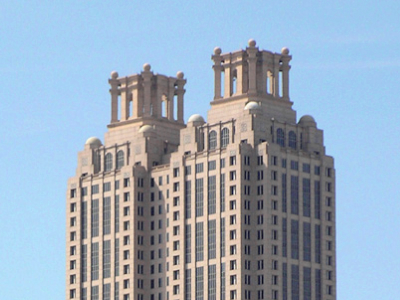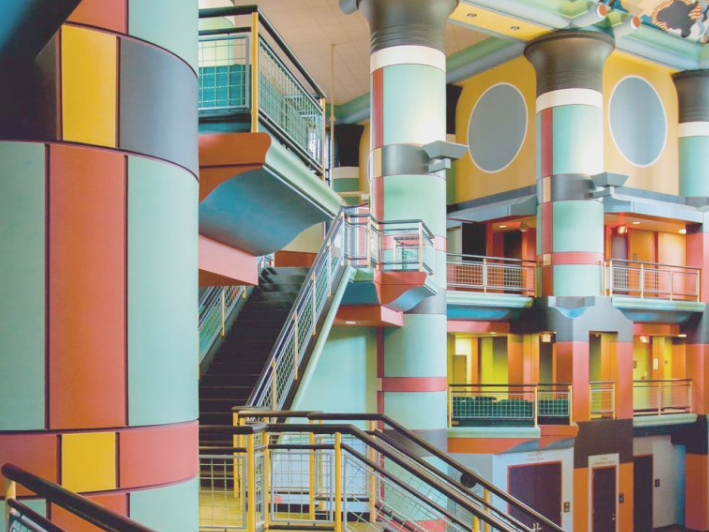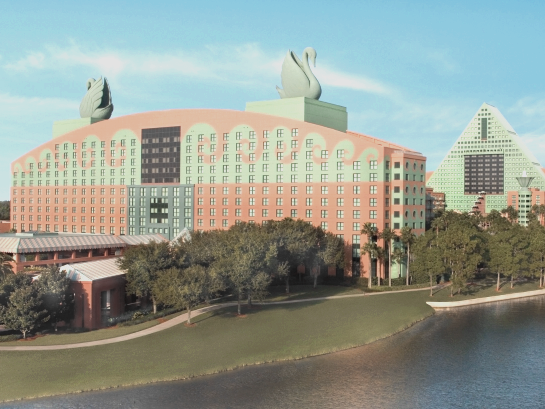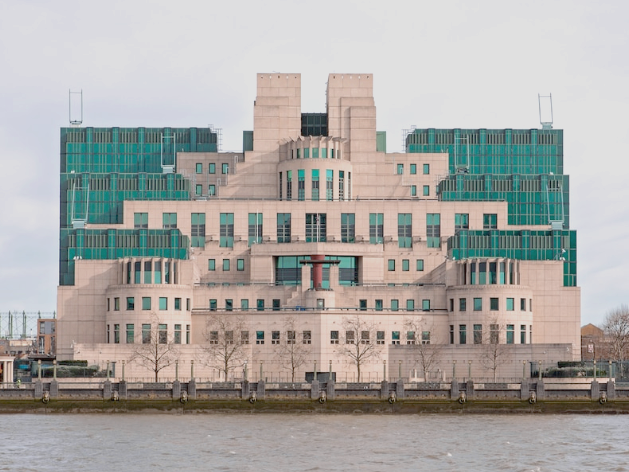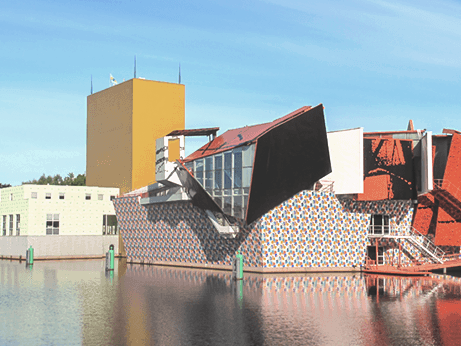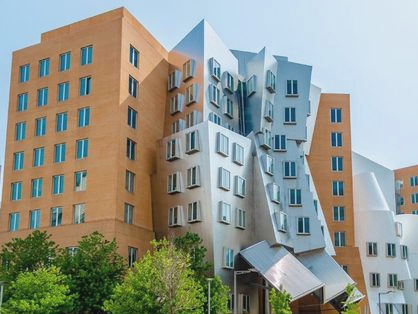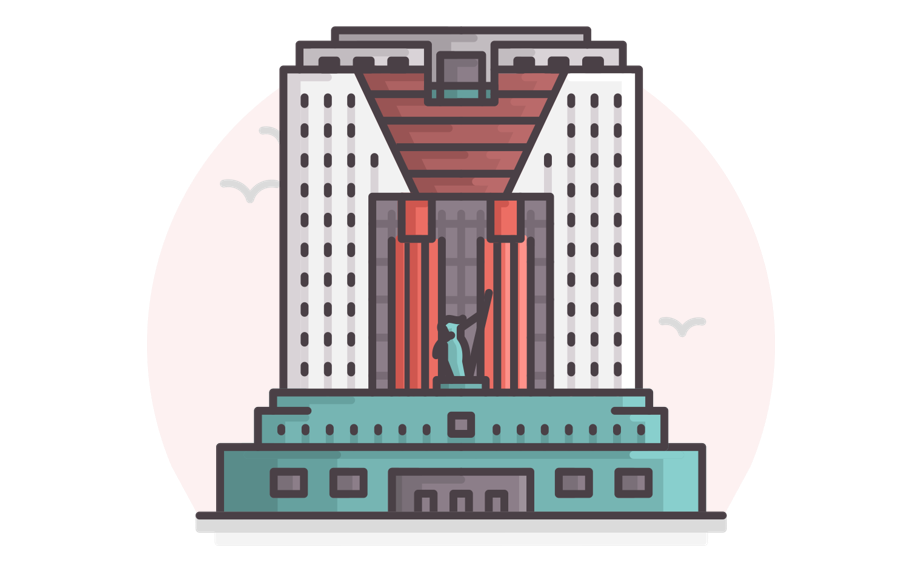
Postmodern Architecture
An architectural rebellion against the modern glass box
« All Arche-tecture | Last Updated 2022
Eccentric. Slightly whacky. And pretty thoroughly dated. These are buildings you would see on the glossy cover of a coffee table book in 1985 and think you were looking at the future. Nowadays you might see them in an exhibit in a modern art museum and know full well you are looking at the past. So what’s with the name? You have to start with the definition of “modern” in its proper context. By the ’80s, the concept of modernity in architecture had slowly grown over time to mean two key things: 1) not looking back to reference past styles, and 2) getting rid of any extraneous ornament. Art Nouveau at the turn of the twentieth century locked in the first part of the definition by looking at least sideways (towards nature) for inspiration instead of the past. But the second part of the definition took a few more decades. Art Deco in the ’20s used minimal, blocky forms, but still had some ornamentation. Streamline Moderne followed in the ’30s and really smoothed out surface details, but it wasn’t until the mid-century International Style and its cousin Brutalism that modernism was on full display.
By the time these two styles proliferated into the ’70s and ’80s, they had moved beyond decorative arts; they had developed into their own dogma. Architects preoccupied themselves with utilitarian philosophizing – if a building decoration had no value to its function, why waste a precious resource on it? If an ornament could not help with the woes of the working class, what purpose did it serve? The movement was of course unsustainable – architects had moved so far along the spectrum away from ornament and historicism that there was really nothing left to strip back. Contemporaneous minds grew discontent with the prude glass box, the preachiness of the philosophy (which ironically aged from democratic to elitist as the decades turned), and so they rebelled. A decorative flourish here wouldn’t hurt the working class, they decided; a building crown, though offering no contribution to its function, wouldn’t take away from its overall utility.
Slowly, the boundaries were pushed in the ’90s until entire buildings were made up of exaggerated, asymmetric bursts of color and shape that served no function other than to represent the humor and taste of the architect. Classical references to columns and pediments, though heavily stylized, were added back in, their juxtaposition next to zany shapes and bold patterns taking on a wholly new, campy aesthetic. And thus, the style had moved beyond mid-century “modern” designs; “post-” modern was born.
Elements

Non-functional decoration
The defining feature of these buildings is the addition of ornament that serves no function. Early on it was sparse, but by the end it was plentiful

Bright, bold colors
International Style and Brutalist buildings were notoriously staid. Post- modern buildings didn’t shy away from color, even brights and pastels

Eccentricity
The humor and expressiveness of each architect was allowed to shine again, reflected in playful and downright eccentric or campy designs

Reinvented Classical references
The “modern” style eschewed all classical references. “Post” modernism started to re-introduce them, but with a heavily stylized, modern twist

Retro feel
Because these buildings came into their own during the 80s and 90s, there is a distinct retro feel that unites them

Sculptural elements
In keeping with the eccentricity theme, many architects added sculptural details to their buildings that made have been viewed as garish previously

Circular + polygonal shapes
The juxtoposition of circular forms with polygonal shapes is common, which creates interesting geometric designs

Color blocking
Supplementing the fun colors of many buildings is a distinct color blocking that further reinforces the bold new elements of the style

Jumbled materials
Materials of all shapes and sizes – metal, glass, stone, concrete – are jumbled together to create unusual designs

Asymmetry
As you would imagine with a style that puts whimsy over discipline, many buildings refuse to conform to symmetric designs

Dysfunction
International Style buildings prided themselves on rational materials, practical shapes, and straight lines. These buildings throw that all out
Experience It

Visit Disney World or Disneyland
Both locations hold a wonderful plethora of postmodern architecture. This is all too fitting, given that a characteristic of this style is the retro feel despite futuristic original vision, which can sum up EPCOT perfectly.

Read "Postmodern Architecture: Less is a Bore"
It’s a beautiful collection of photos from across the world, showcasing the buildings that exemplify the style best. Grab it for your coffee table.

Browse this map
It’s U.S.-centric, but this Curbed article plots out all the great examples of postmodernism in America, with a bit of late modernism thrown in. Use it to plan your next road trip.

Peruse this collection
For a more European view, check out RIBA‘s collection of postmodern info, which includes an examination of its characteristics as well as a gallery of images for purchase.
Comment? Contribution?
If you liked what you read and want to let the author know, if you think there’s something we could add or change, or if you have an idea for a new page that isn’t created yet, get in contact today!

International Style
Postmodernism’s precursor that gave architects the glass box that they would rebel against

Brutalism
The spiritual sibling of the International Style, which also led to postmodern rebellion




